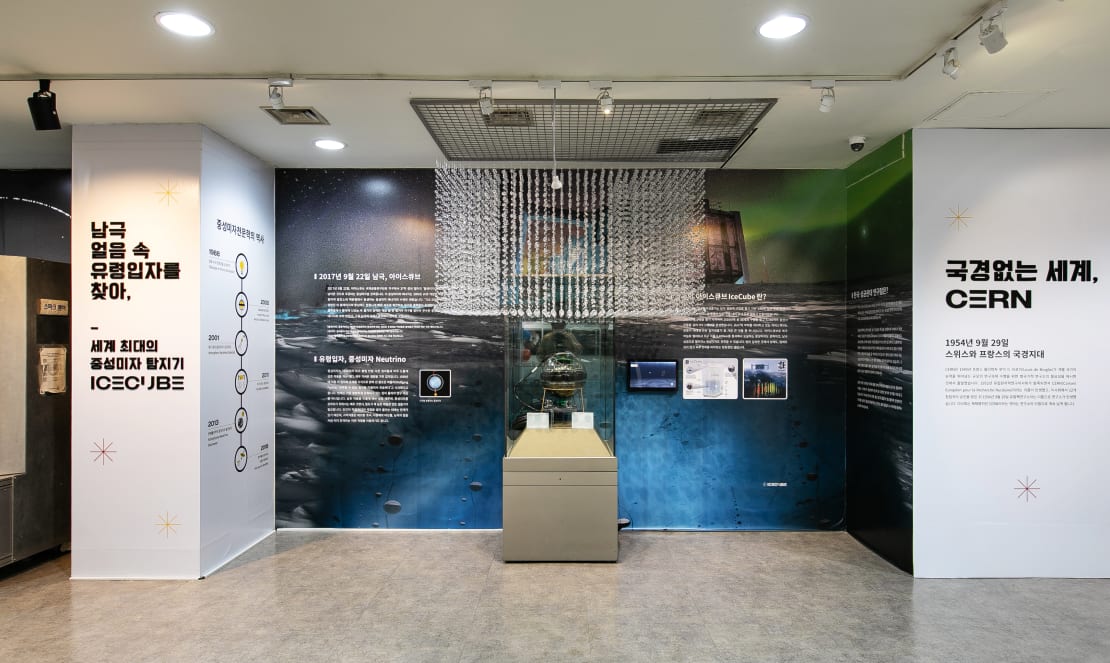The IceCube Neutrino Observatory is included in a new art–science exhibition at the Hanyang University Museum in Seoul, South Korea.
Dr. Michael Hoch, a scientist, artist, and educator with CERN’s CMS experiment who founded the art@CMS and ORIGIN programs “to foster cross-disciplinary science education engagement and networking with the goal of promoting productive dialogues between the science, art, and education communities,” created the exhibit “The Cosmonaut.” ORIGIN is an international science partnership that includes CERN’s LHC experiments, the LIGO and VIRGO gravitational wave collaborations, and IceCube.
Hoch was introduced to IceCube by Mark-David Hosale, a York University professor who has ties to the group. Hoch discussed his upcoming projects with Jim Madsen, IceCube’s associate director of education and outreach; after curating an exhibit about art and particle physics at the Institute for Basic Science (IBS) in Daejeon, Korea, in 2019, Hoch had been invited to bring a similar exhibition—enhanced with scientific topics from all ORIGIN partners active in Korea.
So Madsen connected Hoch to Carsten Rott, the leader of Korea’s lone IceCube group. Rott, a physics professor at Sungkyunkwan University (SKKU), collaborated with Hoch and the museum team to define the exhibit’s scope and discuss how they could add a “personal touch” to the exhibits to relate them to the IceCube research being done in Korea.
Rott and his IceCube team ended up loaning the exhibit the SKKU’s digital optical module (DOM), which is IceCube’s main instrument for detecting photons produced by neutrino interactions. They also contributed one of the 700 camera systems being manufactured and tested at SKKU; Rott and his team’s new camera-based calibration technique is being integrated into all optical modules that will be utilized in an upcoming IceCube upgrade. Woosik Kang (an SKKU IceCube graduate student) and Koun Choi (a former SKKU IceCube postdoc who is currently a research fellow at the IBS Center for Underground Physics) provided Korean wording for the displays and highlighted Korean contributions to assist local students relate better.
“It was quite impressive for me while I was preparing the exhibition because the displayed items (DOM and camera systems) have either been installed in the South Pole for real or will be installed for the IceCube Upgrade,” said Jinkyong Lee, an administrative assistant from Rott’s group at SKKU who assisted with the exhibition’s administrative work. “For students and everyday individuals who are interested in the universe but are not professional researchers, it is inspirational and enlightening. So it was a pleasure for me to create the display with our group members, and I hope it will be useful for young Korean scientists learning about IceCube research.”
The Cosmonaut was planned to premiere in spring 2020, however it was postponed twice due to COVID. It finally opened on May 20, 2021, albeit the museum must still adhere to local COVID safety regulations, which means that fewer and smaller groups are permitted to visit at the same time. It does, however, include a unique online teaching program that is available to anybody in the world, allowing it to have an impact beyond the scope of the pandemic.
The show will run till October 30, 2021 at Hanyang University Museum. On the exhibit’s website, you may learn more about the IceCube section.
Due to COVID constraints, Rott, who just moved to the University of Utah in the United States but continues his association with SKKU, was unable to see the show. Rott, on the other hand, is pleased with the exhibit’s current success. He remarked, “It was thrilling to receive images from the organizers and learn about the student groups enjoying the exhibition.” “At the opening ceremony, I was also quite proud of my student Woosik, who spoke to the audience and explained IceCube science to them. It was also fantastic to see how well my team in Korea worked together to make this event possible, especially since I am now largely at the University of Utah.”
“Preparing the show and standing in front of the crowd at the event’s opening ceremony with the invitation was a wonderful pleasure,” Woosik Kang remarked. “We discussed what would be required to achieve our goal of providing a positive image and inspiration from the IceCube science activities. By watching and chatting with the people who were expressing their curiosity and enthusiasm in the IceCube science at the event, I could see and feel that our efforts had made a significant contribution to the public.”
Hoch expressed his hope that the exhibition’s success will inspire other ORIGIN partners to apply this process and urge people to participate in similar projects. “‘The Cosmonaut’ exhibition and its cross-disciplinary science and art education program, organized by all participating ORIGIN partners, is yet another impressive example of how large international science collaborations collaborate to inspire the next generation on various fundamental topics about the origin of the universe,” Hoch said.


